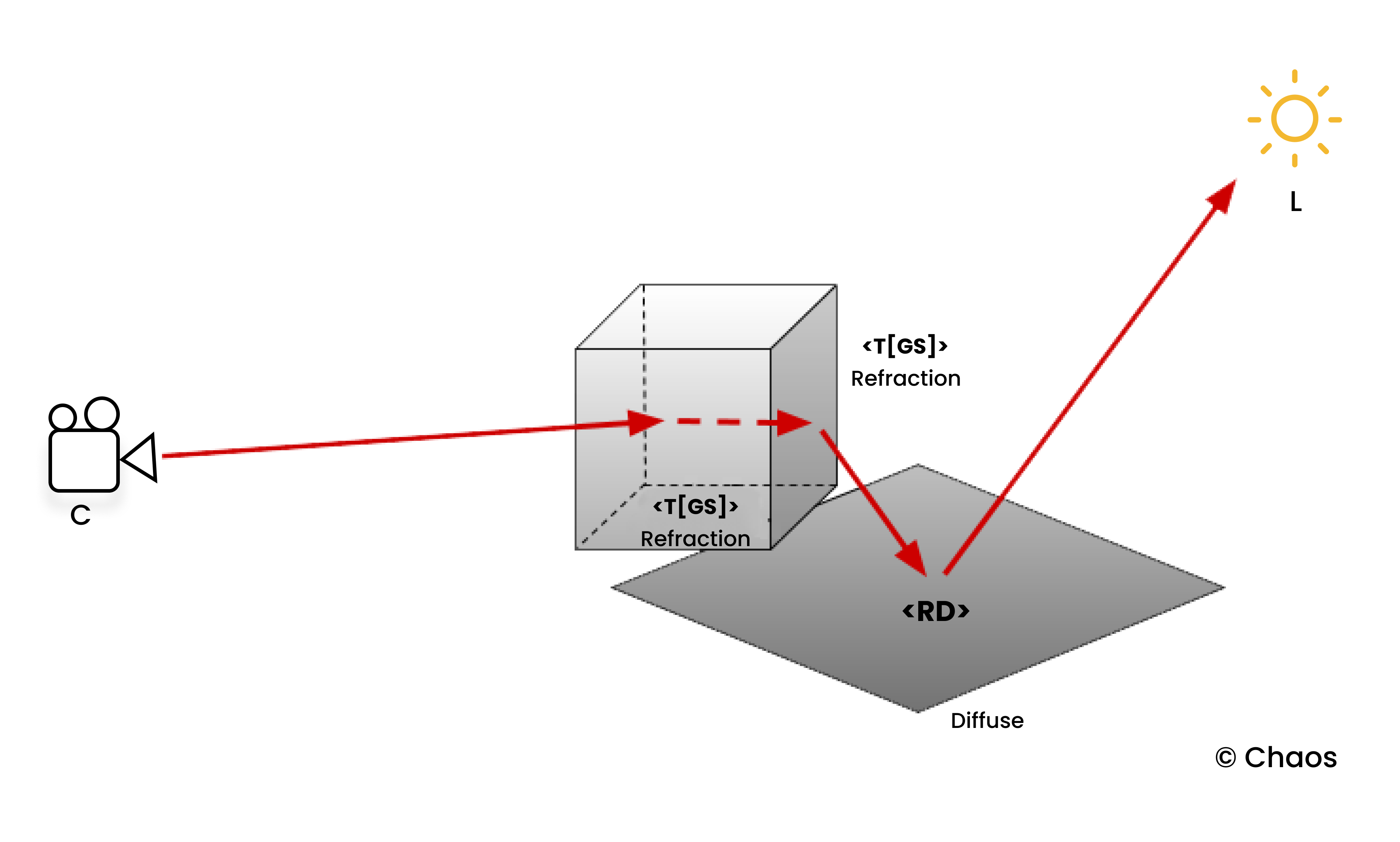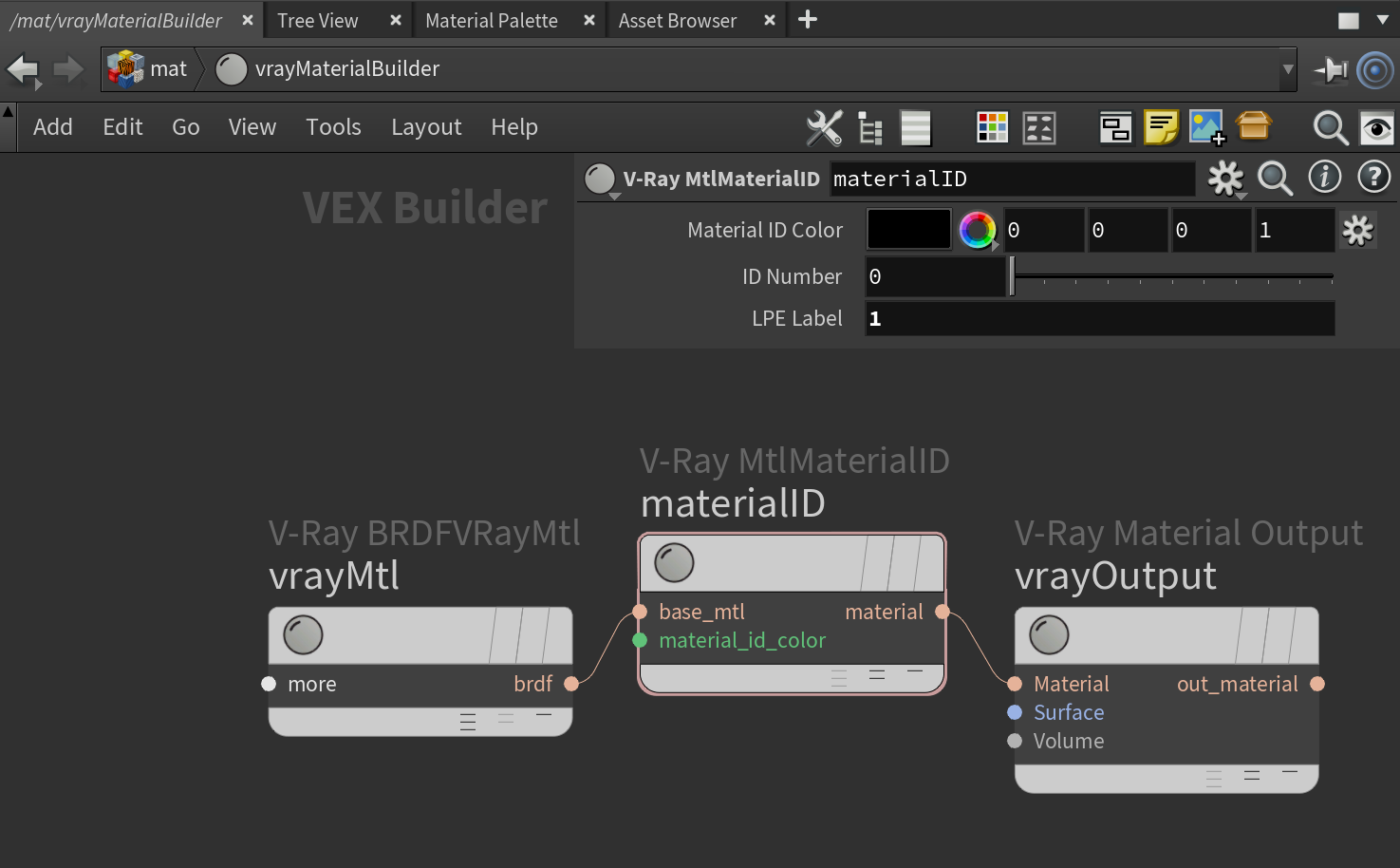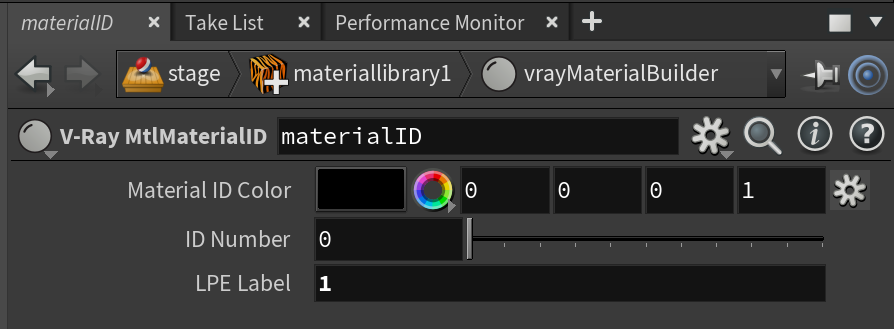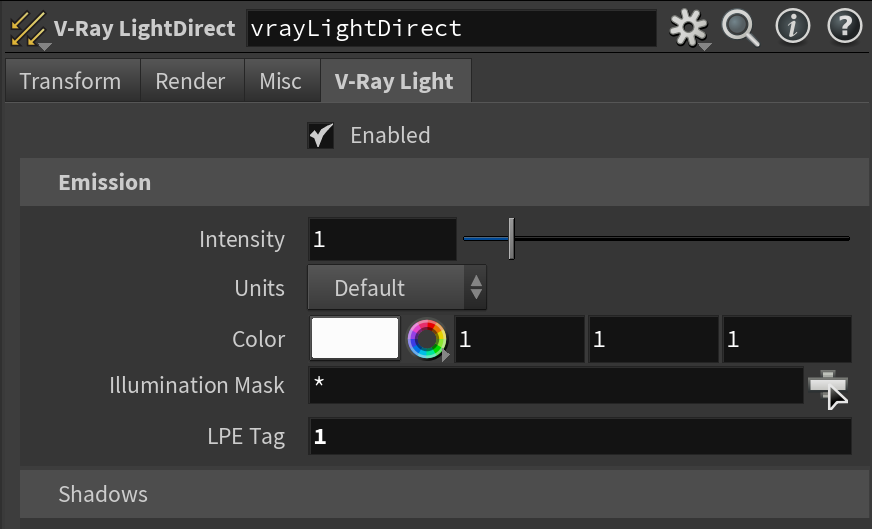Now that we've looked at how LPEs work and know the basics, let's look at some advanced concepts and more ways to use LPEs.
Operations
Light path expressions may also include the modifiers placed after event symbols:
? for 0 or one repetition (or an optional event)
+ for 1 or more repetitions (or indirect). See the + modifier example below.
* for 0 or more repetitions (any)
These can be used in combination with the . symbol. It can signify an arbitrary ray spawn event or an arbitrary scattering type, simply put it stands for any symbol.
Symbols in an expression can be grouped.
[] groups event, scatterings and labels
<> groups event, scatterings and labels
[^] inverts events, scatterings and labels
'' labels for masking objects or materials are placed inside single quotations.
| OR (pipe symbol)
() groups symbols.
| Expression | Equivalent (Description) | Captured ray paths |
|---|---|---|
| C.*L | Full light select | camera (C) → any event (.) that repeats zero or more times (*) → light (L) |
CRL
| Direct light select | camera → diffuse reflection → light |
| CR.+L | Indirect light select | camera → any event (.) that repeats one or more times (+) → light |
CR?L | ? | camera → diffuse reflection → light |
C<RD>L
| Lighting (Direct diffuse reflections) | camera → diffuse reflection → light |
C<R[GS]>L
| Specular (Direct glossy and singular reflections) | camera → glossy reflection → light camera → singular reflection → light |
C<RD'1'>L
| Lighting for object label 1 | camera → diffuse reflection for object with label 1 → light |
C<RD[^'1']>L
| Lighting for all objects other than object label 1 | camera → diffuse reflection for objects that don't have label 1 → light |
C<RD>(.+L|.*[OB])
| GI (Indirect diffuse reflections) | camera → diffuse reflection → any event (.) that repeats one or more times (+) → light camera → diffuse reflection → any event (.) that repeats zero or more times (*) → emission camera → diffuse reflection → any event (.) that repeats zero or more time |
Capture Objects, Materials and Lights
LPEs can be modified to record information for only specific objects or materials by adding a label, or for only specific lights by adding a tag.
LPE labels for objects
If we take C.* as an example, which gives us the Beauty, C.'1'.* will filter the Beauty only for objects with LPE label 1.
C.'cube'.* will be the Beauty only for objects with LPE label cube.
LPE labels to objects are added in the Object Properties. In Solaris, the LPE labels are added in the Render Geometry Settings LOP > V-Ray > LPE tab. The user attribute name needs to be lpe_label and its value can be text or numbers; for instance: lpe_label=1 or lpe_label=cube.
LPE labels can be anything. You can label an object or material 1, or 2, or testObject, or myMaterial.
When used in expressions, labels need to be placed inside single quotes: C.'cube'.*
Information about Object Properties: Object Properties
Information about Object Properties SOP: V-Ray Object Properties SOP
Information about Render Geometry Settings LOP in Solaris: Working with Solaris Geometry
Adding a Light Path Expression label to geometry
Adding a Light Path Expression label to geometry in Solaris
LPE labels for materials
Similarly, C.'m1'.* can be used to separate the Beauty only for materials with material label 1.
C.'mmyMaterial'.* will be the Beauty only for materials with LPE label myMaterial.
LPE labels are added to materials through the V-Ray MaterialID material, which is added between the material and the output nodes. The label can take numeric or text values and when used in an expression it needs to be preceded by m and placed inside in single quotes.
LPE labels can be anything. You can label an object or material 1, or 2, or testObject, or myMaterial.
When used in expressions, material labels require prefixing the label with m and placing the label inside single quotes: C.'m1' or C.'mmyMaterial'.
Information about adding V-Ray Material ID in V-Ray: V-Ray Material ID Material
Information about V-Ray Material ID in Solaris: Working with Solaris Materials
Adding a Light Path Expression label to materials
Adding a Light Path Expression label to materials in Solaris
Inverting LPE labels
Labels can be easily inverted in expressions by adding ^ in front of them and then placing the inversion symbol and the label inside square brackets [ ].
For example, C.[^'m1'].* will give us the Beauty for all materials that do not have material label 1.
We can invert multiple labels at the same time, for example CR[^'1''2'].+L filters the indirect illumination for all objects that do not have the labels 1 and 2.
LPE tags for lights
C.*<L.'1'> will filter the light contribution of lights with LPE tag 1. It works the same way as a light select.
C.*<L.'topLight'> will be the light contribution from lights with LPE tag topLight.
Another more advanced example is C<RD>.+<L.'1'>, which isolates the GI of a specific light with LPE tag 1.
(C<RD>(.+L|.*[OB]))-(C<RD>.+<L.'1'>) filters the GI of all lights in the scene except for the lights with LPE tag 1.
LPE tags are added to lights through the LPE Tag parameter of the light.
Information about V-Ray lights: Lights
Information about V-Ray lights in Solaris: Working with Solaris Lights
Adding a Light Path Expression tag to lights
Adding a Light Path Expression tag to lights in Solaris
Boolean operations
Boolean operations allow us to combine expressions. We can complement (^), intersect (&) or unite (|) expressions, or we can subtract (-) one expression from another.
Let's look at some examples.
GI can be broken down to different types of light sources: lights, self-illuminating objects, and the environment. If we need to control each of these separately in compositing, we can use the built-in presets, respectively: C<RD>.+L, C<RD>.*O and C<RD>.*B. The combination of these in compositing (with a plus) replaces the GI channel in a back-to-beauty composite. However, if we only need to grade the GI from Lights, we can render a GI render element and C<RD>.+L. Then, we subtract C<RD>.+L from the GI in compositing, grade C<RD>.+L and add it back to the composite.
Alternatively, we can render GI and an LPE for GI minus C<RD>.+L. In this way, we'll only need to add the graded C<RD>.+L channel to the GI in compositing, saving us some compositing complexity.
For the purpose of this example, we can do a union of the GI coming from all three types of light sources to get the GI using the pipe symbol for union: (C<RD>.+L)|(C<RD>.*O)|(C<RD>.*B)
Boolean operations can also be very useful when using LPEs with object or material labels.
Let's look at a simple example with direct lighting. V-Ray already has a render element for this (Lighting) and the equivalent expression is C<RD>L. If we additionally want to capture direct lighting falling onto object(s) labeled cube, we need to render an LPE for C<RD'cube'>L. We can then subtract C<RD'cube'>L from the Lighting channel in compositing, grade it, and add it back in.
Alternatively, we can render the C<RD'cube'>L expression and a second one that does the subtraction right in the renderer: (C<RD>L)-(C<RD'cube'>L). We then grade each channel as needed and add them with a plus in the composite.






